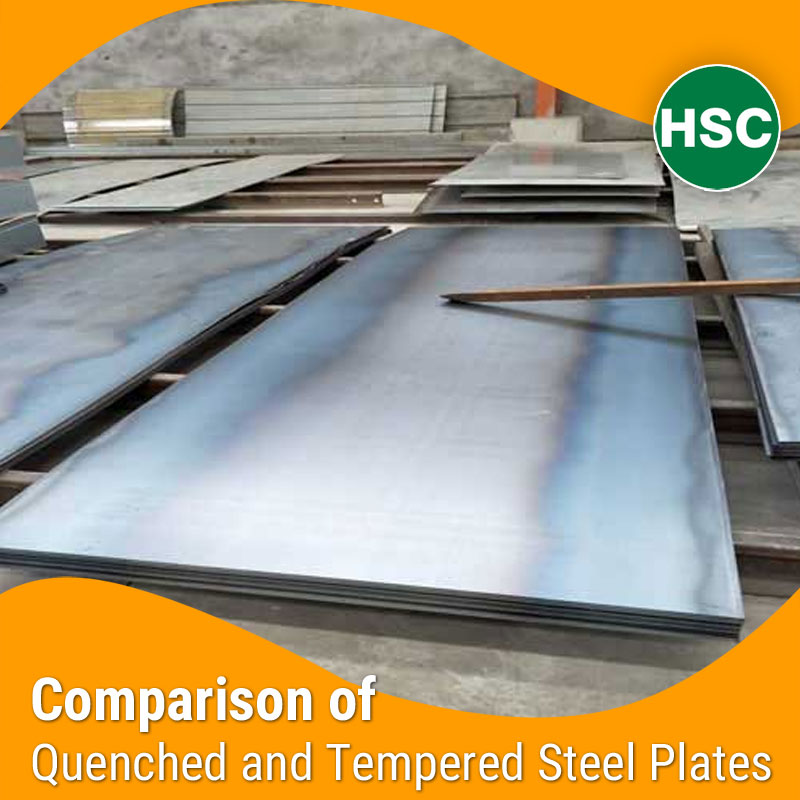Why This Comparison Matters
When sourcing steel plates for heavy-duty fabrication, two common categories dominate buyer discussions:
- Quenched & Tempered (Q&T) Plates – used in structural, crane, trailer, and defence projects
- Normalized Boiler Plates – used for pressure vessels, heat exchangers, and boiler shells
Many first-time buyers confuse the two — or assume they are interchangeable. But that’s a costly mistake.
This blog helps you understand which one to use — and why choosing wrongly can result in project failure, code non-compliance, or structural risk.
Heat Treatment: Quenching vs Normalizing
| Process | Quenched & Tempered (Q&T) Plates | Normalized Boiler Plates |
|---|---|---|
| Step 1 | Heated above 900°C (austenitizing) | Heated to ~920°C (austenitizing) |
| Step 2 | Rapid quenching in water/oil (hardens grain) | Cooled in still air (refines grain size) |
| Step 3 | Tempering at ~550°C–700°C | No tempering; normalizing is a single stage |
| Result | High strength, high hardness, good toughness | Balanced strength, ductility, pressure-safe |
| Microstructure | Tempered martensite | Refined ferrite-pearlite |
| Intended Use | Load-bearing, dynamic stress, abrasion | Pressure vessels, steam/chemical containment |
🔍 Conclusion: Q&T = strength and wear.
Normalized = stability under internal pressure and heat.
Mechanical Properties at a Glance
| Property | Q&T Plate (e.g., S690QL) | Normalized Plate (e.g., SA 516 Gr 70) |
|---|---|---|
| Yield Strength (MPa) | 690 – 1100 | 260 – 355 |
| Tensile Strength (MPa) | 770 – 1100 | 490 – 585 |
| Elongation (%) | 10 – 17 | 17 – 23 |
| Impact Resistance | High @ -40°C | Moderate @ 0°C or ambient |
| Welding Complexity | High (preheat needed) | Low (easy weldability) |
| Thickness Range | 6 – 120 mm | 6 – 150 mm |
💡 Key takeaway:
- Q&T plates outperform in mechanical strength, fatigue, and abrasion
- Normalized boiler plates excel in ductility and internal pressure resistance
Application-Based Use Case Comparison
| Use Case | Best Choice | Reason |
|---|---|---|
| Structural crane booms | Q&T Plates | High yield needed for lightweight, high-load design |
| Trailer chassis & lifting arms | Q&T Plates | Withstands stress and impact in mobile structures |
| Boiler shells & pressure vessels | Normalized Boiler Plates | Designed for internal pressure + temperature stability |
| Heat exchangers & reactors | Normalized Boiler Plates | Thermal cycling resistance, easy welding |
| Defence & vehicle armor | Q&T Plates | High strength-to-weight, ballistic resistance options |
| Construction equipment (buckets) | Q&T Plates | Abrasion resistance and strength |
| Storage tanks for oil/chemicals | Normalized Boiler Plates | Large size, weldable, pressure-safe |
🟢 Tip:
- If your concern is mechanical stress or impact, use Q&T.
- If it’s internal pressure or temperature exposure, go with Normalized.
Fabrication & Welding Considerations
| Factor | Q&T Plates | Normalized Boiler Plates |
|---|---|---|
| Welding Preheat | Often needed (>20mm thick) | Rarely needed |
| Heat Input Range | Strictly controlled | Wide tolerance |
| Post-Weld Treatment | Not allowed (alters temper) | Can be stress-relieved if required |
| Cutting Method | CNC plasma / laser preferred | Gas cutting acceptable |
| Edge Preparation | Required for fit-up and beveling | Standard practices apply |
⚠️ Note: Overheating Q&T plates during fabrication destroys mechanical properties. Welders must follow precise WPS.
Standards & Certifications
| Plate Type | Common Standards |
|---|---|
| Q&T Plates | EN 10025-6 (S690QL, S890QL), ASTM A514, JFE HITEN |
| Normalized Plates | ASTM A516 (Gr 60/70), IS 2002, P265GH, 16Mo3, SA387 |
💬 Ask for test certificates with:
- CE Value
- UT Scan
- Charpy impact @ relevant temp
- EN10204 3.1 / 3.2 if project needs it
Availability in India – What’s Easy to Source?
| Grade Type | Availability | Notes |
|---|---|---|
| Q&T Plates | Stock-dependent | Common up to 690QL; above 890 often on order basis |
| Normalized Boiler Plates | Widely available | Stocked by most suppliers in 8–100 mm range |
🏢 Hindustan Steel Corporation stocks and supplies:
- Ready-to-dispatch Q&T plates (HIND Q&T 400 to 890)
- Boiler-grade IS 2002 / SA516 / P265GH / 16Mo3 with full MTC
- Custom profiling, edge beveling, CNC shaping, and mill test documents
Final Recommendation – Which Steel Should You Choose?
✅ Go with Q&T Plates if:
- You need high yield strength (690 MPa+)
- Your application involves dynamic loading, high impact, or abrasion resistance
- You are fabricating cranes, structural parts, defence vehicles, buckets, lifting arms
✅ Go with Normalized Boiler Plates if:
- Your design needs internal pressure stability and weldability
- You are building boilers, reactors, pressure vessels, or thermal equipment
- You need easier fabrication and standard compliance with ASME/IS/EN pressure codes
Buyer’s Checklist Before Finalizing
✔ Confirm required mechanical properties (yield, tensile)
✔ Check temperature and pressure design limits
✔ Verify code compliance (EN 10025-6, ASTM A516, etc.)
✔ Review fabrication method and WPS requirements
✔ Get MTC with CE value, impact test, heat treatment method
✔ Confirm if post-weld heat treatment is allowed (only for normalized plates)
✔ Request CNC cutting and edge prep if needed

